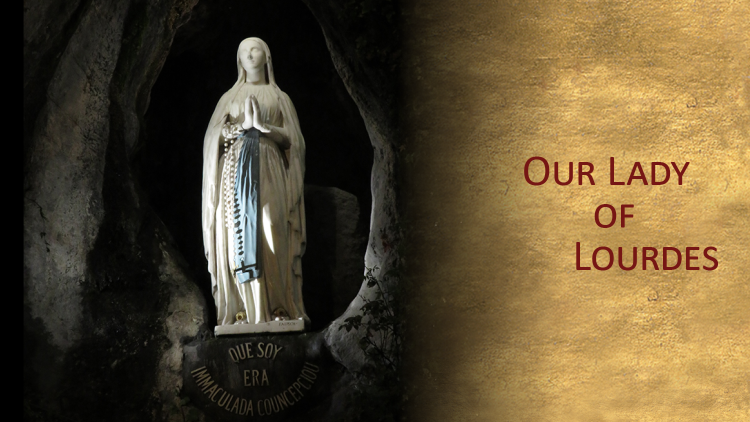
Optional Memorial of Our Lady of Lourdes
Today’s liturgical memorial recalls the apparitions of the Virgin Mary in Lourdes which began on 11 February 1858. The protagonist of this series of events was a girl named Bernadette Soubirous, today numbered among the host of Saints. Mary appeared to her eighteen times near a grotto along the banks of the Gave River. The details of Bernadette’s experience were gathered by the Diocesan Commission charged to examine the facts. From this investigation, we know that Bernadette found herself on the banks of the river along with some other girls when she heard a sort of “gust of wind” coming from the grotto. She drew near, but the leaves on the trees were not moving. While she was trying to understand what was happening, she heard another “sound” and saw a white figure in the shape of a lady. Fearing that she was hallucinating, she rubbed her eyes, but She was still there. Not knowing what to do, she took her rosary out of her pocket and began to recite it, and the Virgin joined her in prayer. One of the girls with Bernadette, was her sister, to whom Bernadette confided what had happened. As soon as they arrived back home, her sister told their mother, who forbade them from returning there. News spread throughout the area, and Bernadette returned with a group of friends to the location on 14 February, when the second apparition took place.
Invitation to return for 15 days
Another apparition took place on 18 February during which the Virgin asked her to return for 15 consecutive days. On the 25th, the “Lady” asked Bernadette to eat some weeds as an act of penitence. She also indicated a place where Bernadette was to go and drink water. Finding a puddle of water, Bernadette began digging with her hands until there was enough clean water for her to drink.
I am the Immaculate Conception
On 25 March, at Bernadette’s request, the Virgin said she was the Immaculate Conception. This dogma of faith had been promulgated by Pope Pius IX on 8 December 1854.
The apparitions
The apparitions took place from 11 February to 16 July, with varying time lapses in between: 11, 14, 18, 19, 20, 21, 23, 24, 25, 27, 28 February 1958; 1, 2, 3, 4 and 25 March; 7 April and 16 July. The apparitions were officially recognized by the Bishop of Tarbes on 18 January 1862.
Shrine for the sick
Lourdes is famous not so much for the apparitions themselves, but for the message of hope for all those who suffer in body and spirit. Ever since the apparitions, Lourdes is known as the place that welcomes all who are physically or spiritually ill and who, through the intercession of the Virgin Mary, the Immaculate Conception, seek to rediscover peace, health and serenity. Seventy healings have been recognized by an autonomous group of physicians – as well as many conversions.
On the third day there was a marriage at Cana in Galilee, and the mother of Jesus was there; Jesus also was invited to the marriage, with his disciples. When the wine gave out, the mother of Jesus said to him, “They have no wine.” And Jesus said to her, “O woman, what have you to do with me? My hour has not yet come.” His mother said to the servants, “Do whatever he tells you.” Now six stone jars were standing there, for the Jewish rites of purification, each holding twenty or thirty gallons. Jesus said to them, “Fill the jars with water.” And they filled them up to the brim. He said to them, “Now draw some out, and take it to the steward of the feast.” So they took it. When the steward of the feast tasted the water now become wine, and did not know where it came from (though the servants who had drawn the water knew), the steward of the feast called the bridegroom 10 and said to him, “Every man serves the good wine first; and when men have drunk freely, then the poor wine; but you have kept the good wine until now.” This, the first of his signs, Jesus did at Cana in Galilee, and manifested his glory; and his disciples believed in him. (Jn. 2:1-12)
Cana and Lourdes
In this perspective, the significance of today’s memorial can be understood. Still today, the Virgin Mary is the one who continues to intercede for her children, particularly for those who are weak, those who physically and spiritually ill. She entrusts them to Jesus, our Lord and Savior, the only One who can transform water into wine, who can transform every difficulty into joy, every grief into hope, every illness into newfound confidence.
World Day of the Sick
The message of the wedding at Cana and Lourdes leads us to understand why, in 1992, Pope Saint John Paul II chose this day as the World Day of the Sick. Lourdes teaches us that no person whatsoever who is sick can ever be discarded, but must be fully inserted into life like any other person.








